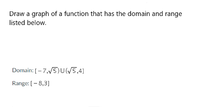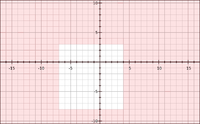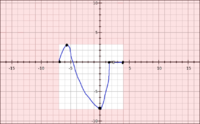Last edited by a moderator:
You are using an out of date browser. It may not display this or other websites correctly.
You should upgrade or use an alternative browser.
You should upgrade or use an alternative browser.
Not quite sure how to go about drawing a graph given the domain and range
- Thread starter mickey222
- Start date
D
Deleted member 4993
Guest
Sketch your "intentions" and post a photograph. Then we can critique it!What would this graph look like? So far, I've plotted a horizontal line along the X axis reaching, basically, from -7 to 4 (yes, I know about the stopping points because of the square root of five), as well as a vertical line from -8 to 3.
What else should I do? I am a bit confused.
View attachment 24257
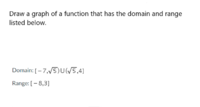
HallsofIvy
Elite Member
- Joined
- Jan 27, 2012
- Messages
- 7,763
Perhaps you are confused because there is NO function given! The problem says "graph a function" so make one up yourself! A linear function or even a constant function would do.
Dr.Peterson
Elite Member
- Joined
- Nov 12, 2017
- Messages
- 16,088
The graph you draw has to be contained in the rectangle defined by the intervals you drew (though your lines on the axes are not directly relevant). That is, sketch in lines perpendicular to your lines, at their endpoints.What would this graph look like? So far, I've plotted a horizontal line along the X axis reaching, basically, from -7 to 4 (yes, I know about the stopping points because of the square root of five), as well as a vertical line from -8 to 3.
What else should I do? I am a bit confused.
View attachment 24257
But it can't be just any function within that; it must touch all four sides of that rectangle, in some sense. And you have to also omit the one point in the domain without omitting anything in the range, so a linear function won't work. I'd consider something looking like a quadratic or a cubic with a "hole".
Beyond that, you have a lot of freedom to be creative; please show us an image of whatever you have drawn, so we can guide you along.
Sketch your "intentions" and post a photograph. Then we can critique it!
show us an image of whatever you have drawn, so we can guide you along.
This is my attempt so far... I don't know why I'm having such an issue with it. I tried a piecewise function as I have no idea how to achieve this with a single quadratic or cubic function, or a single function of any kind. . Would that be a legitimate way to go about this?
The reason I don't know how to use a quadratic function for this is twofold: I don't know where to put the vertex and 2. Not sure how I deal with the excluded point (square root of five which is about 2.23 on the X axis).
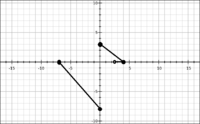
lev888
Elite Member
- Joined
- Jan 16, 2018
- Messages
- 2,939
As I understand the problem, you only need to draw a graph, you don't need to show the function. So draw whatever you want as long as it remains a valid graph. Yours is not valid - a function can't have more than one y value for any x.This is my attempt so far... I don't know why I'm having such an issue with it. I tried a piecewise function as I have no idea how to achieve this with a single quadratic or cubic function, or a single function of any kind. . Would that be a legitimate way to go about this?
The reason I don't know how to use a quadratic function for this is twofold: I don't know where to put the vertex and 2. Not sure how I deal with the excluded point (square root of five which is about 2.23 on the X axis).
View attachment 24289
Dr.Peterson
Elite Member
- Joined
- Nov 12, 2017
- Messages
- 16,088
You may be forgetting that a function doesn't have to be of a particular named type, or even to have a formula at all. I would just sketch a curve freehand.This is my attempt so far... I don't know why I'm having such an issue with it. I tried a piecewise function as I have no idea how to achieve this with a single quadratic or cubic function, or a single function of any kind. . Would that be a legitimate way to go about this?
The reason I don't know how to use a quadratic function for this is twofold: I don't know where to put the vertex and 2. Not sure how I deal with the excluded point (square root of five which is about 2.23 on the X axis).
View attachment 24289
Here is the rectangle I described:
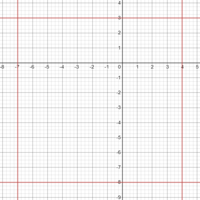
Just draw a squiggle in there that touches the lines, maybe like this (though your two lines would be fine, with some modifications):
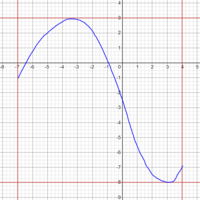
Now just think about how you can exclude the one value from the domain, without missing anything in the range.
Otis
Elite Member
- Joined
- Apr 22, 2015
- Messages
- 4,414
Hi mickey. I'd guess the reason has something to do with not enough practice using (or thinking about) the mathematical definition of a function, before getting this exercise.… I don't know why I'm having such an issue with it…
Have you heard of the Vertical Line Test, for determining whether an xy-graph represents a functional relationship between x and y?
?
Hi mickey. I'd guess the reason has something to do with not enough practice using (or thinking about) the mathematical definition of a function, before getting this exercise.
Have you heard of the Vertical Line Test, for determining whether an xy-graph represents a functional relationship between x and y?
?
You're not supposed to say it out loud... just kidding. Yes I was familiar with the vertical line test at the time I created that function, but it slippe dmy mind. THanks for reminding me.
Steven G
Elite Member
- Joined
- Dec 30, 2014
- Messages
- 14,383
Major hint: Assume that the initial problem was to draw the function where the domain is [-7, sqrt(5)) and the range is [-8,3]. After drawing this function can you just add onto it to include the part of the domain (sqrt(5), 4] while maintaining the given range.
Steven G
Elite Member
- Joined
- Dec 30, 2014
- Messages
- 14,383
The problem clearly states to draw a graph of a function.Here is my latest attempt to answer the question, which I misread horribly. I thought it was asking me to draw a function. Assuming it isn't... here we go:
do the "excluded" points require any kind of representation in this image?
View attachment 24300
So go back and draw any function that lives up to the domain and range. Use the hint which I provided in my last post.
Okay, here is a rough sketch. I was actually in the middle of doing what you asked before I read your request, because I thought I ought to include the graph of a function as well. **edit** I colored in the point (0,3) while not needing to.The problem clearly states to draw a graph of a function.
So go back and draw any function that lives up to the domain and range. Use the hint which I provided in my last post.
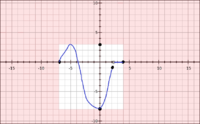
Steven G
Elite Member
- Joined
- Dec 30, 2014
- Messages
- 14,383
Lets call your function f(x). Based on your graph can you tell me the (approximate) value of f(sqrt(5))?Okay, here is a rough sketch. I was actually in the middle of doing what you asked before I read your request, because I thought I ought to include the graph of a function as well. **edit** I colored in the point (0,3) while not needing to.
View attachment 24301
My understanding is that the square root of 5 is omitted from the function, so it wouldn't have a value, so undefined?Lets call your function f(x). Based on your graph can you tell me the (approximate) value of f(sqrt(5))?
I deleted my last response when I realized I read your question incorrectly.
lev888
Elite Member
- Joined
- Jan 16, 2018
- Messages
- 2,939
What's the meaning of the black dot on the right end of the curved portion of your graph?My understanding is that the square root of 5 is omitted from the function, so it wouldn't have a value, so undefined?
I deleted my last response when I realized I read your question incorrectly.
What's the meaning of the black dot on the right end of the curved portion of your graph?
It was representing the square root of five, which was supposed to be omitted from my domain, so I removed it in the above graph.

